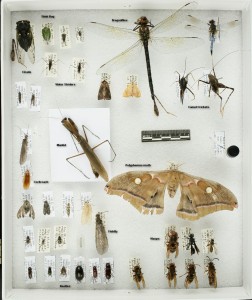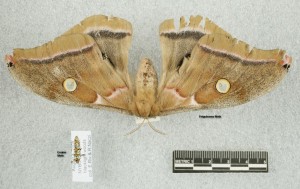Nighttime Prowls Turn Up Plenty of Insects
Posted in Science, Wildlife on January 20 2010, by Plant Talk
Project Looks to Catalog Six-Legged Residents and More
 |
Edgardo Rivera is Senior Curatorial Assistant in the William and Lynda Steere Herbarium. |
 Many people walk through the Forest at NYBG in search of a break from the city and without concern for the names of the trees and flowers they encounter along the path. Others may stop occasionally to watch a passing chipmunk or to photograph the jewelweed. More tenacious individuals, armed with binoculars or perhaps a zoom lens on a camera, will specifically seek out the feathered denizens of the Forest but not many give a second look for the armored creatures that fly past them, the cold-blooded ones that slither under rotting logs, or the nocturnal beings that sit quietly under debris waiting for night to fall.
Many people walk through the Forest at NYBG in search of a break from the city and without concern for the names of the trees and flowers they encounter along the path. Others may stop occasionally to watch a passing chipmunk or to photograph the jewelweed. More tenacious individuals, armed with binoculars or perhaps a zoom lens on a camera, will specifically seek out the feathered denizens of the Forest but not many give a second look for the armored creatures that fly past them, the cold-blooded ones that slither under rotting logs, or the nocturnal beings that sit quietly under debris waiting for night to fall.
However, an effort to catalog these creatures is under way as part of the Garden’s Natural History project. Led by Jessica A. Schuler, Manager of the Forest, and Rob Naczi, Ph.D., Curator of North American Botany, the project has assembled specialists from different fields to identify the flora, fauna, and geography of the many habitats within the Forest.
 There has probably never been a systematic survey of the insects of NYBG, and the last major checklist of the insects of New York State is over 80 years old and doesn’t mention the Garden by name. I agreed to help collect insects, and Dr. Naczi and I began surveying after dark. From mid-summer to winter, we went into the Forest at dusk, tied a rope between two trees, and from this hung a white sheet. We used an ultraviolet (UV) light to attract insects to the sheet. Unlike people, insects see UV light quite well. In fact, many insects are attracted to it, and many plants have UV-reflecting patterns in their flowers that effectively draw pollinators.
There has probably never been a systematic survey of the insects of NYBG, and the last major checklist of the insects of New York State is over 80 years old and doesn’t mention the Garden by name. I agreed to help collect insects, and Dr. Naczi and I began surveying after dark. From mid-summer to winter, we went into the Forest at dusk, tied a rope between two trees, and from this hung a white sheet. We used an ultraviolet (UV) light to attract insects to the sheet. Unlike people, insects see UV light quite well. In fact, many insects are attracted to it, and many plants have UV-reflecting patterns in their flowers that effectively draw pollinators.
Among the more than 400 individuals we collected were over 200 species of beetles, a few of which are possibly rare for this region. We also collected some impressive, almost prehistoric-looking camel crickets; a mantispid, which as its name suggests resembles a tiny mantis but with the wings of a fly; and many other interesting insects (see photo above right).
Collecting was not limited to the Forest at night. A polyphemus moth (see photo above left) was collected from a post along the Forest path one morning, dragonflies were collected near Twin Lakes, and a mantis in the gardens in front of the Conservatory.
The cold weather has put a stop to our collecting, but we hope to resume in the spring. Meanwhile, I hope more people pay attention to the six-legged residents of the Garden.

